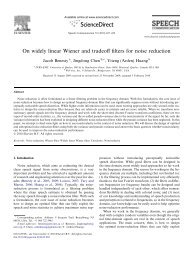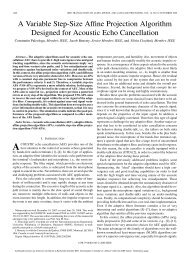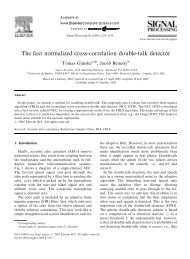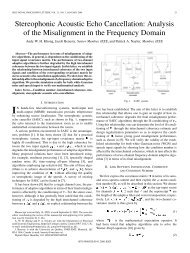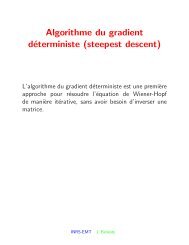A Generalized MVDR Spectrum - ResearchGate
A Generalized MVDR Spectrum - ResearchGate
A Generalized MVDR Spectrum - ResearchGate
Create successful ePaper yourself
Turn your PDF publications into a flip-book with our unique Google optimized e-Paper software.
830 IEEE SIGNAL PROCESSING LETTERS, VOL. 12, NO. 12, DECEMBER 2005<br />
We can easily check that<br />
(35)<br />
(36)<br />
Inserting these expressions in the Cauchy–Schwartz inequality<br />
(37)<br />
we see that .<br />
Property 4 was, of course, expected in order that the definition<br />
(27) of the MSC could have a sense.<br />
C. Simulation Example<br />
In this subsection, we compare the MSC function estimated<br />
with our approach and with the MATLAB function “cohere”<br />
that uses the Welch’s averaged periodogram method [7]. We<br />
consider the illustrative example of two signals and<br />
that do not have that much in common, except for two sinusoids<br />
at frequencies and<br />
(38)<br />
(39)<br />
where and are two independent zero-mean (real)<br />
white Gaussian random processes with unit variance. The<br />
phases and in the signal are random. In this<br />
example, the theoretical coherence should be equal to at<br />
the two frequencies and and at the others. Here we<br />
chose and . For both algorithms, we<br />
took 1024 samples and a window of length . As for<br />
the choice of the unitary matrix in our approach, we took the<br />
Fourier matrix. Fig. 1(a) and (b) give the MSC estimated with<br />
MATLAB and our method, respectively. Clearly, the estimation<br />
of the coherence function with our algorithm is much closer to<br />
its theoretical values.<br />
IV. CONCLUSION<br />
The <strong>MVDR</strong> principle is very popular in array processing<br />
and spectral estimation. In this letter, we have shown that this<br />
concept can be generalized to unitary matrices other than the<br />
Fig. 1.<br />
Estimation of the MSC function. (a) MATLAB function “cohere.” (b)<br />
Proposed algorithm with U = F. Conditions of simulations: K =100and a<br />
number of samples of 1024.<br />
Fourier transform for spectrum evaluation. Most importantly,<br />
we have given an alternative to the popular Welch’s method for<br />
the estimation of the MSC function. Simulations show that the<br />
new method works much better.<br />
REFERENCES<br />
[1] S. L. Marple, Jr., Digital Spectral Analysis with Applications. Englewood<br />
Cliffs, NJ: Prentice-Hall, 1987.<br />
[2] S. M. Kay, Modern Spectral Estimation: Theory and Application. Englewood<br />
Cliffs, NJ: Prentice-Hall, 1988.<br />
[3] P. Stoica and R. L. Moses, Introduction to Spectral Analysis. Upper<br />
Saddle River, NJ: Prentice-Hall, 1997.<br />
[4] J. Capon, “High resolution frequency-wavenumber spectrum analysis,”<br />
Proc. IEEE, vol. 57, no. 8, pp. 1408–1418, Aug. 1969.<br />
[5] R. T. Lacoss, “Data adaptive spectral analysis methods,” Geophys., vol.<br />
36, pp. 661–675, Aug. 1971.<br />
[6] P. Stoica, A. Jakobsson, and J. Li, “Matched-filter bank interpretation<br />
of some spectral estimators,” Signal Process., vol. 66, pp. 45–59, Apr.<br />
1998.<br />
[7] P. D. Welch, “The use of fast Fourier transform for the estimation of<br />
power spectra: A method based on time averaging over short, modified<br />
periodograms,” IEEE Trans. Audio Electroacoust., vol. AU-15, no. 2,<br />
pp. 70–73, Jun. 1967.<br />
[8] R. M. Gray, “Toeplitz and Circulant Matrices: A Review,” Stanford<br />
Univ., Stanford, CA, Int. Rep., 2002.<br />
[9] S. Haykin, Adaptive Filter Theory, 4th ed. Englewood Cliffs, NJ: Prentice-Hall,<br />
2002.



